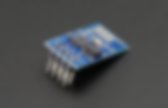

Nixie Clock on ESP8266 module. Power ESP32/ESP8266 with Solar Panels and Battery. This tutorial shows step-by-step how to power the ESP32 development board with solar panels, a 18650 lithium battery and the TP4056 battery charger module.

The circuit we’ll build is also compatible with the ESP8266 or any microcontroller that is powered at 3.3V. When you power your ESP32 with solar panels, it may be useful to use its deep sleep capabilities to save power. Learn everything you need to know about deep sleep with the ESP32 with our guide: ESP32 Deep Sleep with Arduino IDE and Wake Up Sources. Parts Required To power the ESP32 or ESP8266 with solar panels, we’ll use the following parts: You can use the preceding links or go directly to MakerAdvisor.com/tools to find all the parts for your projects at the best price! ESP32 Solar Powered – Circuit Overview The following diagram shows how the circuit to power the ESP32 with solar panels works.
Solar Panels The solar panels we’re using have an output voltage up to between 5V to 6V. TP4056 Charger Module Voltage Regulator analogRead(0); Hackster. Duck And Cover With This WiFi “Geiger Counter” There’s perhaps no sound more recognizable than the frantic clicking of a Geiger counter.

Not because this is some post-apocalyptic world in which everyone is personally acquainted with the operation of said devices, but because it’s such a common effect used in many movies, TV shows, and video games. If somebody hears that noise, even if it doesn’t really make sense in context, they know things are about to get serious. Capitalizing on this phenomena, [Anton Haidai] has put together a quick hack which turns the ESP8266 into a “Geiger counter” for WiFi.
Rather than detecting radiation, the gadget picks up on the strongest nearby WiFi signal and will start clicking in response to signal strength. As the signal gets stronger, so does the clicking. The hardware is really about as simple as it gets, just a basic buzzer attached to one of the digital pins on a NodeMCU development board. Domestic Central Heating Radiator Efficiency Optimiser. It was supposed to take 30 seconds to get data into the Cloud from opening the dev board's box, but it took me over an hour just to get the demo software going!

First I used an old (32-bit) laptop running Lubuntu. It seems that one needs to give the serial USB port ttyACM0 some kind of access rights but that is easily found online. Suffice to say words to the effect of 1. add user to dialup and 2. ensure read/write access. I tried to drag the hex file onto the USB port but with random success.
I tried on a Win10 machine and didn't have any major problems. The board's instructions suggested 's' compile option but that is only available in the PRO version of the XC-8 compiler. IoT IR Programmable Transcoder - TV Remote on Steroids. Background You when something annoys you so much you just have to fix it especially if every one else nags you.
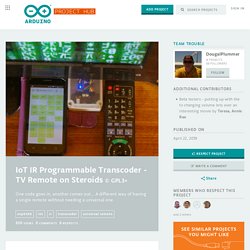
Our television remote falls in this category, its a "Dick Smith" brand unit and has a dodgy intermittent remote. I've used universal remotes before and even after hours of programming them they are not so flash. Esprfid/esp-rfid: ESP8266 RFID (RC522, PN532, Wiegand, RDM6300) Access Control system featuring WebSocket, JSON, NTP Client, Javascript, SPIFFS. Minnow Server is a Secure Web Server for Microcontrollers. Many embedded systems have a limited amount of memory, which would normally run programs with smaller footprints than on desktops or servers.

For example, nginx and Apache2 are the common web servers, but on hardware with limited memory, smaller footprint web servers may be required, so that’s why I wrote a list of web servers for embedded systems running Linux/uClinux many years ago. But now, even platforms based on microcontrollers often need to run web server usually for configuration.
We’ve already shown how to use Arduino to serve a simple web page and did the same in Getting Started with NodeMCU Board Powered by ESP8266 WiSoC but using Lua programming language instead. It may be more convenient to run a proper web server however, as it’s easier to change the interface, and we previously covered MicroWebSrv lightweight web server that works on platforms running MicroPython such as Pycom boards. ESP - ESP Communication with WGET and MSGBRACNH. For a complete index of all my stories click this text The general purpose of this story is a way to send data directly between ESP-8266's.
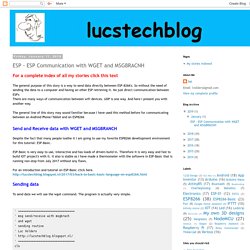
So without the need of sending the data to a computer and having an other ESP retrieving it. No just direct communication between ESP'sThere are many ways of communication between wifi devices. UDP is one way. And here I present you with another way. Pushbutton → Push Notification. How many mundane devices upgrade to IoT because they let you monitor a single data point or a variable?

That little nudge over the communication precipice allows you to charge 500% more. Now, if you are as handy as a Hackaday reader, you can throw a lazy afternoon at the problem and get the same effect from a “dumb” appliance. If IoT is as simple as getting a notification when your laundry is dry, or your water is boiling, all you really need is a WiFi device and a push notification, right? Does it need to be more complicated than that? [Gianni] believes it is that simple (machine translation) and has built up an easy-to-implement version on Raspberry Pi, Arduino, and ESP8266. WiFi Air Quality Station.
I was very intrigued when the very inexpensive ESP8266 module hit the market.
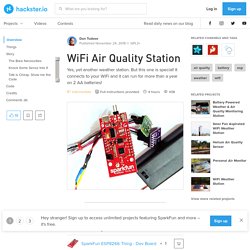
All of a sudden you could add full WiFi functionality to basically any project at a very low price. I was even more intrigued when I read this article about how you can set the module to a very low power state in which it could lay dormant for more than an hour. This opened an interesting opportunity of having battery-powered IoT applications that connect directly to your WiFi router. I had to see if it could be done! The Bare Necessities. Build Yourself This ESP8266 Pong Game with VGA Output. Detect Your Friend's Devices with a NodeMCU MAC Address Sniffer [Tutorial] Xoseperez / fauxmoESP / source / Amazon Alexa support for ESP8266 and ESP32 devices.
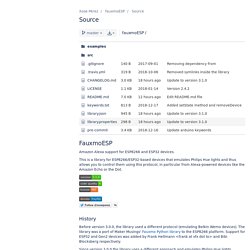
This is a library for ESP8266/ESP32-based devices that emulates Philips Hue lights and thus allows you to control them using this protocol, in particular from Alexa-powered devices like the Amazon Echo or the Dot. Before version 3.0.0, the library used a different protocol (emulating Belkin Wemo devices). The library was a port of Maker Musings' Fauxmo Python library to the ESP8266 platform. Support for ESP32 and Gen2 devices was added by Frank Hellmann <frank at vfx dot to> and Bibi Blocksberg respectively. Since version 3.0.0 the library uses a different approach and emulates Philips Hue lights instead. ESP8266 Deep-Sleep with Periodic Wake-up.
The esp8266 can last for years on battery in deep-sleep mode, so that’s a good place to start.

The question really is how often can it wake-up? The best way to find out is to run some experiments! Wi-Fi Controlled Robot Using Wemos D1 ESP8266 and Blynk. In this tutorial I show you how to make a Wi-Fi controlled robotic tank controlled from a smartphone using Blynk App. In this project an ESP8266 Wemos D1 board was used, but other plate models can also be used (NodeMCU, Firebeetle, etc.), and the principles presented in this tutorial can be applied to other robot models. In previous projects I presented how to mount a robot controller with an Arduino Uno connected to an ESP8266 module and a web interface using html and javascript. A robot was developed using simple materials, without the need of using complex tools such as 3D printers and laser cutting machines.
The ESPaper Calendar. The ESP8266-based ESPaper Calendar is built around the 2.9” ESPaper Plus Kit, which is a fully assembled Wi-Fi ePaper display DIY kit. The ESPaper Calendar offers a clever way of managing shared resources. By connecting it to a cloud calendar, it lets you manage meeting rooms or shared desks. The embedded app loads calendar resources from the Google Calendar, Apple iCloud Calendar and Microsoft Outlook.com, thus displaying current availability and upcoming meetings. No wiring is required. The ESPaper Calendar runs on a battery which can last for weeks, because the e-Paper consumes energy only when the content needs to be changed.
Alarm !! For an index of all my stories click this text This story tells about an alarm for paintings, But do not be set off by that. You can use the same alarm for doors that open, drawers and cookie jars. As you might know by now, my girlfriend paints and often has expositions. Due to the new and utterly stupid privacy laws in the Netherlands I had to blur out the faces from this photo. At this moment she has an exposition in a gallery that shares its place with the local library.
Siara-cc/esp_arduino_sqlite3_lib: Sqlite3 library for ESP8266 Arduino core. Calebbrewer/secret-knock-magnetic-door-lock. ESP8266 NTSC C64 Emulator. Adding Energy Use and Cost to “Laundry Done” Notifications. Some time ago [Xose Pérez] got interested in generating a notification when his washer had completed a cycle, and now with added features like reporting power usage and cost, he’s put it all together into a Node-Red node that makes it easy to modify or integrate with other projects.
[Xose] started this journey with a Laundry Monitor he created that effectively used cheap hardware (and his own firmware) to monitor his washing machine’s current usage. That sensor was used as the basis for sending notifications informing him whenever the appliance’s cycle was done. Since then, he has continued to take household power monitoring seriously, and with a bit of added work can not only tell when a given appliance has been started and stopped, but can also summarize the energy usage and cost of the appliance, making the notifications more useful.
Low Power ESP8266 – Sleeping at 78 micro Amps – tim.jagenberg.info. I recently bumped into NodeMCU firmware for the ESP8266. It’s an Lua interpreter, making tinkering with IoT ideas really simple. Just flash the firmware onto the ESP8266 and connect via serial console. You can start prototyping right away using the interactive Lua interpreter. VFD Clock II Displays Time, Date, and Text Via WiFi. RTL-SDR Paves Way To Alexa Controlled Blinds. ESP8266, Deep Sleep mode test, wake up with a PIR motion detector. The ESP8266 module has the deep sleep mode which allows to put it in hibernation to save the battery. It's leaking. After living for several years in our house we decided to have all our window frames replaced by plastic window frames. No more painting. Basics — Micropython on ESP8266 Workshop 1.0 documentation. Running NodeMCU on a battery: ESP8266 low power consumption revisited – Tinkering with Technology.
Over the last year I have standardised on the ESP8266 for all my small IoT projects. Its low price, ease of use (now that the Arduino IDE is available), tiny size and built in Wi-Fi makes it a compelling option. Making the ESP8266 Low-Powered With Deep Sleep. Wemos D1 Mini Temperature/humidity Monitoring: 3 Steps. When pins are soldered you can stack board and shields together and configure board by Arduino IDE. Build Multisensor Shield for ESP8266.
Breadboard hack for ESP32 and ESP8266. For an index to all my stories click this text. Simple ESP8266 Weather Station using Blynk. Today’s hacker finds themself in a very interesting moment in time. The availability of powerful microcontrollers and standardized sensor modules is such that assembling the hardware for something like an Internet-connected environmental monitor is about as complex as building with LEGO. Hardware has become elementary in many cases, leaving software as the weak link. It’s easy to build the sensor node to collect the data, but how do you display it in a useful and appealing way? This simple indoor temperature and humidity sensor put together by [Shyam Ravi] shows one possible solution to the problem using Blynk. Fun Evening Project (Of Course I COULD Have Used a Sonoff But...) Put the Adafruit HUZZAH Feather ESP8266 to Deep Sleep with One Wire and One Line of Code.
Going Retro with the BASIC Engine – Hackster Blog. Cheap Sensors Help People Understand the Air They Breathe. Hackster. For Just $6, You Can Build a Portable Weather Station that Monitors the Weather Wherever You Are. Energy Monitor Using an ESP8266EX – Hackster's Blog. $10 Motion Alarm That WORKS! No Fees & Works ANYWHERE! ThingPulse/esp8266-spotify-remote: Lets you control your spotify player from a ESP8266 with color touch screen. Controlling 7 segment LED display with ESP8266 Web Server – EverythingESP. Alexa-Powered Dust Collection – Hackster Blog. Wi-Fi Smart Scale (with ESP8266, Arduino IDE, Adafruit.io and IFTTT) AdWords We use AdWords to deploy digital advertising on sites supported by AdWords. Ads are based on both AdWords data and behavioral data that we collect while you’re on our sites. The data we collect may include pages you’ve visited, trials you’ve initiated, videos you’ve played, purchases you’ve made, and your IP address or device ID.
This information may be combined with data that AdWords has collected from you. We use the data that we provide to AdWords to better customize your digital advertising experience and present you with more relevant ads. LiveRamp We use LiveRamp to deploy digital advertising on sites supported by LiveRamp. UpSellIt We use UpSellIt to help create a more streamlined shopping cart experience. #21: Six Sonoff Secrets – SuperHouse Automation. Low Power ESP8266 – Sleeping at 78 micro Amps. ThisSmartHouse/coogle-switch: An ESP8266 Switch on/off Firmware based on CoogleIOT. Mc Lighting. Making a Web Thing on the ESP8266 – Mozilla Hacks – the Web developer blog. Sensor bouwen – luftdaten.info – Feinstaub selber messen. Smart Smoke Detector Build. Fun and Unique Electronics for Everyone! Alexa (Echo) with ESP32 and ESP8266. Social Stats Tracker Display With ESP8266: 4 Steps (with Pictures)
DIY Interface Module: ESP8266 & 2.8 inch TFT Screen. Pi-Hole Stats on an ESPaper Display. ESP8266: Monitoring Power Consumption - ThingPulse. How to drive RGB LEDs with ESP32 & ESP8266 - Not Enough TECH. Hacking a Sonoff WiFi Switch. IoT Enabled Sensor Data Collection Centre With ... Guest Video: Brian Lough - ESP8266 Libraries. K.C.'s Garage: Sonoff S31 Disassemble and Flash Instructions. WiFi Controlled LED Wedding Table Pieces: 13 Steps. IOT ESP8266 Tutorial - Using nodeMCU/LUA. CoRE: New ESP8266 Development Stick by rXTX – EverythingESP. Finding Your Motorbike Using Wi-Fi. MySensors - Create your own Connected Home Experience. Espple: A Wireless Apple 1 on an ESP8266. Feed Your Cat The Modern Way. Nextion Display with ESP8266 UI Node-RED. The WiFi Repeater You Probably Have on Your Bench. IOT ESP8266 Timer Tutorial - Arduino IDE - SwitchDoc Labs.
ESP8266/ESP-12 Arduino Powered SmartThings DS18B20 Temp. Sensor : 4 Steps (with Pictures) ESP8266 WiFi Analyzer: 5 Steps (with Pictures) Hackster. ESP8266 MAX7219 Dot Matrix Display as MQTT Client. A Beginner's Guide to the ESP8266. Analog Pull-Down resistor. ESP8266 - Li-Ion Battery Rechargeable Battery Power Solution: 4 Steps (with Pictures) Bootstrap: create a beautiful Web Interface for your projects ESP8266. Martyn Currey. Adding an MCP23017 16 port IO expander to Arduino or Esp8266 or Attiny85 or…….. – Arduino & ESP8266 stuff. #Hack: SONOFF S20 plug to make it a super intelligent plug with ESP Easy. Playing With a ESP8266 WiFi Module · William Durand. Using Gmail with OAUTH2 in Linux and on an ESP8266. ESP8266 and MLX90393 magnetic field sensor example - esp8266 learning.
Ask Hackaday: Is The ESP8266 5V Tolerant? 3.3v Step Down Power Supply For ESP 8266 – IoT Bytes. Minimizing ESP8266 Battery Drain. Wemos D1 mini 2017 versions. #171 Arduino Guide to Infrared (IR) Communication also for ESP32 and ESP8266. In-Circuit ESP8266 Programming Tool. Hoe je het Internet of Things beveiligt in 10 stappen. ESP8266 Project: Desktop Weather Station With WIFI. Solar Soil Moisture Meter With ESP8266: 10 Steps (with Pictures) Gianbacchio/ESP8266-TelegramBot: Telegram Bot Library for ESP8266 on Arduino IDE. Everyone Loves Faster ESP8266 TFT Libs.